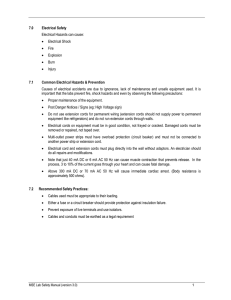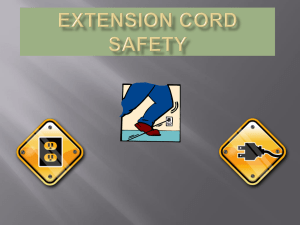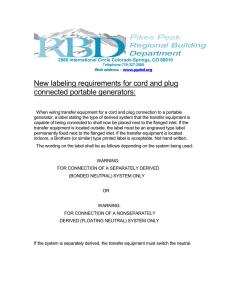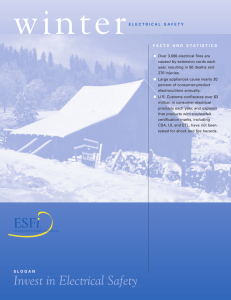Power Supply Cord Safety in Portable Fans and Heaters
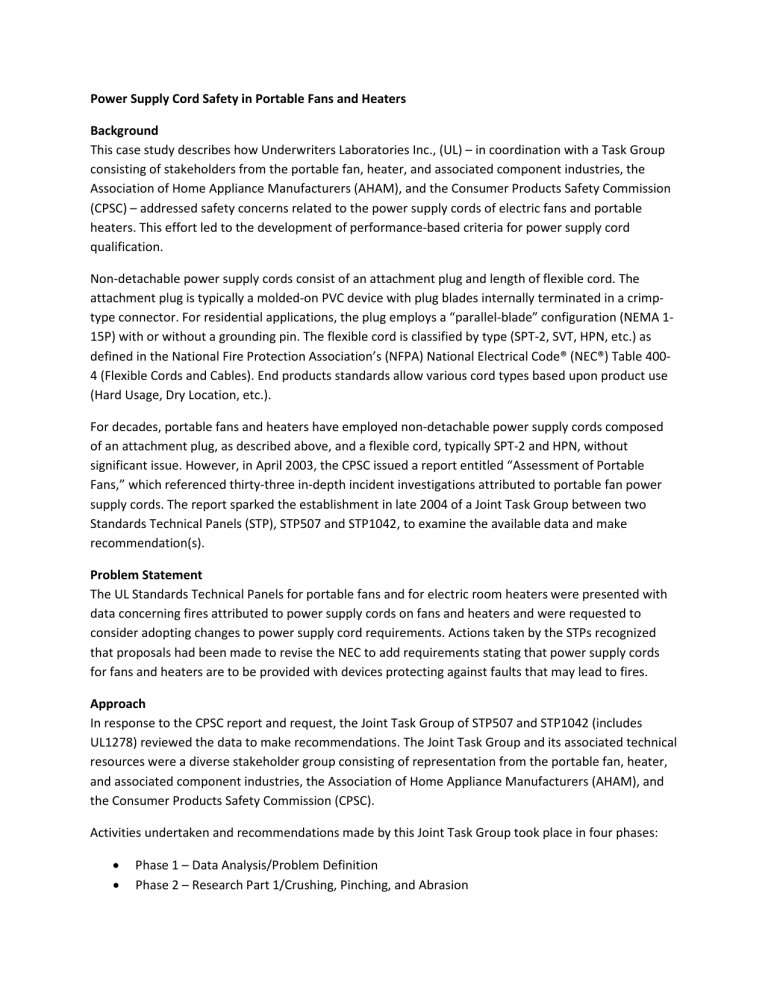
Power Supply Cord Safety in Portable Fans and Heaters
Background
This case study describes how Underwriters Laboratories Inc., (UL) – in coordination with a Task Group consisting of stakeholders from the portable fan, heater, and associated component industries, the
Association of Home Appliance Manufacturers (AHAM), and the Consumer Products Safety Commission
(CPSC) – addressed safety concerns related to the power supply cords of electric fans and portable heaters. This effort led to the development of performance-based criteria for power supply cord qualification.
Non-detachable power supply cords consist of an attachment plug and length of flexible cord. The attachment plug is typically a molded-on PVC device with plug blades internally terminated in a crimptype connector. For residential applications, the plug employs a “parallel-blade” configuration (NEMA 1-
15P) with or without a grounding pin. The flexible cord is classified by type (SPT-2, SVT, HPN, etc.) as defined in the National Fire Protection Association’s (NFPA) National Electrical Code® (NEC®) Table 400-
4 (Flexible Cords and Cables). End products standards allow various cord types based upon product use
(Hard Usage, Dry Location, etc.).
For decades, portable fans and heaters have employed non-detachable power supply cords composed of an attachment plug, as described above, and a flexible cord, typically SPT-2 and HPN, without significant issue. However, in April 2003, the CPSC issued a report entitled “Assessment of Portable
Fans,” which referenced thirty-three in-depth incident investigations attributed to portable fan power supply cords. The report sparked the establishment in late 2004 of a Joint Task Group between two
Standards Technical Panels (STP), STP507 and STP1042, to examine the available data and make recommendation(s).
Problem Statement
The UL Standards Technical Panels for portable fans and for electric room heaters were presented with data concerning fires attributed to power supply cords on fans and heaters and were requested to consider adopting changes to power supply cord requirements. Actions taken by the STPs recognized that proposals had been made to revise the NEC to add requirements stating that power supply cords for fans and heaters are to be provided with devices protecting against faults that may lead to fires.
Approach
In response to the CPSC report and request, the Joint Task Group of STP507 and STP1042 (includes
UL1278) reviewed the data to make recommendations. The Joint Task Group and its associated technical resources were a diverse stakeholder group consisting of representation from the portable fan, heater, and associated component industries, the Association of Home Appliance Manufacturers (AHAM), and the Consumer Products Safety Commission (CPSC).
Activities undertaken and recommendations made by this Joint Task Group took place in four phases:
• Phase 1 – Data Analysis/Problem Definition
• Phase 2 – Research Part 1/Crushing, Pinching, and Abrasion
• Phase 3 – Research Part 2/Flexing
• Phase 4 - Proposals
Outcome
Revisions to UL 507 for electric fans and UL 1278/UL1042 for electric heaters were published. These revisions included performance test criteria for abrasion, pinching, and crushing intended to align power supply cord performance with the median SJT cord performance as determined by a research study. In addition, flexing criteria was defined to maintain existing performance. Residential fans with typical loads in the 0.5 – 3A range were afforded an additional degree of protection through requirements for supplemental overcurrent protection rated 5A or less.
The new cord performance requirements have since been adopted by the Standards Technical Panel for
UL 62, Standard for Safety for Flexible Cords and Cables , as requirements for rugged cords. This revision allows for the manufacture of flexible cords meeting the performance requirements and marked by the rugged cord identification suffix, -R, creating a new class of power supply cords including SPT-2-R, HPN-
R, SJT-R, and SVT-R flexible cord.
While it is undoubtedly too soon to judge the long-term success of the project, UL has enjoyed positive feedback thus far from critical stakeholders including the CPSC, code panel membership, and manufacturers. Proposals to the NEC did not progress due to actions taken by UL and the Task Group membership.
